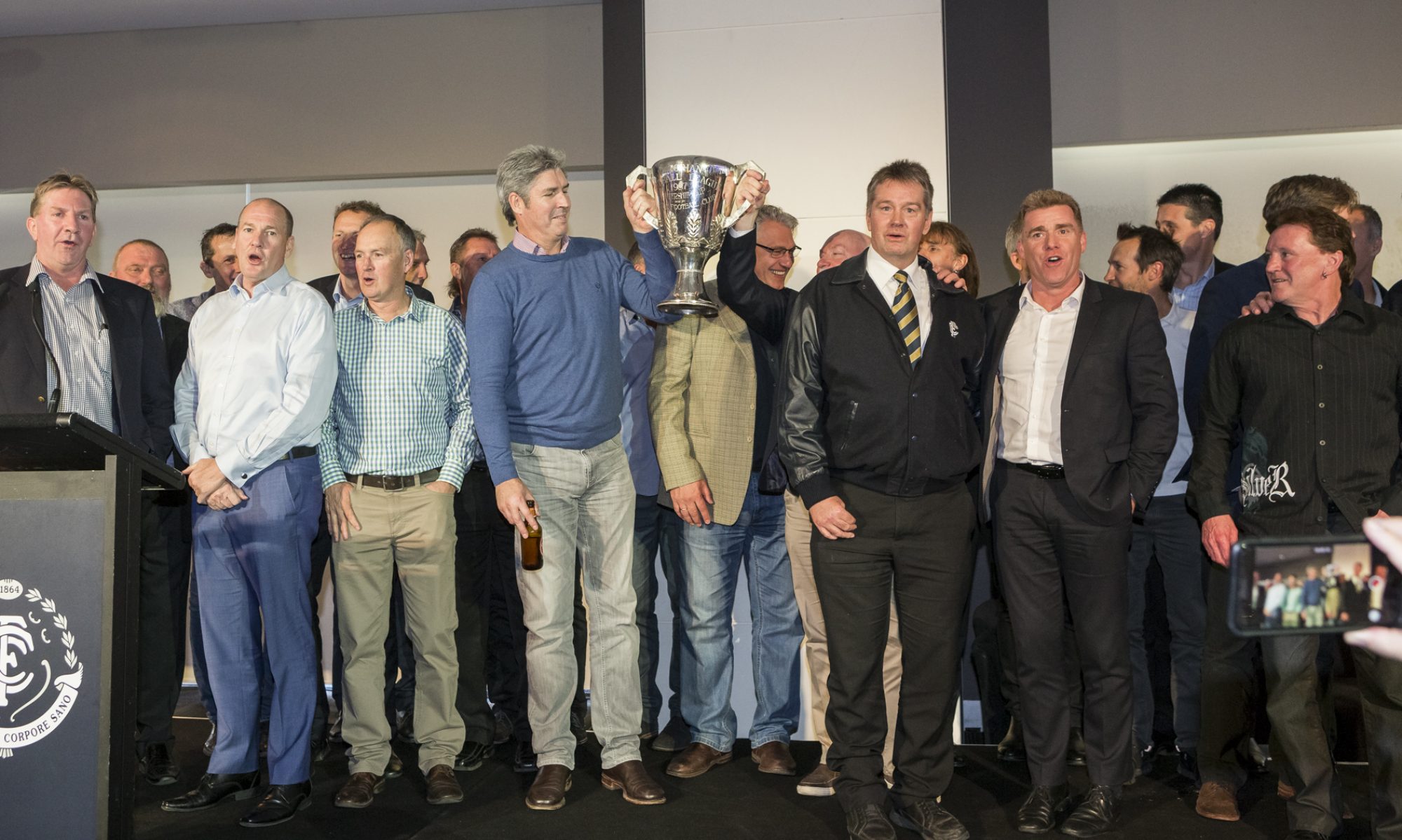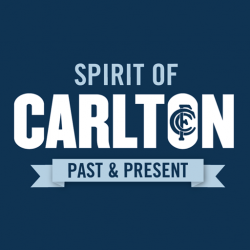November 1st: Leo Brereton Happy 75th Birthday!
 Career : 1957 –62
Career : 1957 –62
Debut : Round 1, 1957 vs Hawthorn
Carlton Player No. 707
Games : 72
Goals : 129
Guernsey No. 6
Last Game: Preliminary Final, 1962 vs Geelong
Height : 174cm
Weight : 70kg
DOB : 1 November, 1936
Leading Goalkicker: 1960
Recruited from the Murray River town of Cohuna, Brereton was a small, nippy rover with excellent goal sense. He wore guernsey number 6 in his 72 games for the Blues in seasons 1957 to ’62, including finals appearances in 1957, 1959 and 1962.
Brereton would share his debut game in 1957 with Club Great John Nicholls.
A skilled crumber, he kicked 130 career goals, including 44 in 1960 to win Carlton’s goal kicking award.
November 2nd
Henry Ogilvie: Happy 70th Birthday!
Career : 1962 – 1963
Debut : Round 6, 1962 vs Collingwood, aged 20 years, 205 days
Carlton Player No. 749
Games : 2
Goals : 0
Last Game : Round 18, 1963 vs Footscray, aged 21 years, 308 days
Guernsey Nos. 24 (1962), 37 (1963)
Height : 184 cm (6 ft. 1 in.)
Weight : 79.5 kg (12 stone, 7 lbs.)
DOB : November 2, 1941
A lightly-framed, athletic defender from Ararat, Henry Ogilvie played two matches for Carlton in seasons 1962-63, wearing a different guernsey number in each of them. Remarkably, there was one year, three months and thirteen days between his debut game in 1962, and his second and last appearance in 1963.
Warren Jones
 Career : 1978 – 1985
Career : 1978 – 1985
Debut : Round 1, 1978 vs Richmond, aged 24 years, 150 days
Carlton Player No. 871
Games : 92
Goals : 31
Last Game: Round 3, 1985 vs North Melbourne, aged 31 years, 162 days
Guernsey No. 2
Height: 200 cm (6 ft. 7 in.)
Weight : 103 kg (16 stone, 3 lbs.)
DOB : 2 November, 1953
Premiership Player : 1982
Warren “Wow” Jones added more than his share to the rich tapestry of the Carlton Football Club in his 92 games for the Blues between 1978 and 1985. Perhaps best remembered for the myth that grew from his nickname, Wow was a heavily-tattooed giant at 200 cm and 102 kg – but one whose forbidding appearance hid a surprisingly gentle nature off the field.
November 4th: Luke Livingston
 Career : 2002 – 2006
Career : 2002 – 2006
Debut : Round 4, 2002 vs Port Adelaide, aged 19 years, 168 days
Carlton Player No. 1052
Games : 46
Goals : 2
Guernsey No. 4
Last Game : Round 11, 2006 vs West Coast, aged 23 years, 219 days
Height : 190 cm (6 ft. 2 in.)
Weight : 92 kg (14 stone, 7 lbs.)
DOB: 4 November, 1982
Luke Livingston was taken at Pick No. 4 in the 2000 National Draft, the draft selection Carlton received from St Kilda as part of the trade for then club favourite Aaron Hamill. There were high expectations that Livingston, at 190cm, would become a star key position player for the Blues. Livingston was drafted from the Bendigo Pioneers U/18’s, with Kerang being his junior club.
‘Livo’ was given the prized number 4 guernsey worn by Hamill, but made famous by our long-serving, dual Premiership captain, Stephen Kernahan. He played the first half of 2001 in the VFL, but then suffered a knee injury, followed by a life-threatening bowel disorder. He therefore had to wait until 2002 to make his debut, in round 4. This was also the year after Full Back of the Century Stephen Silvagni retired, leaving a void in defence that would be impossible to fill. Luke played 17 games in his first year – mainly at full-back, against some the best full forwards in the competition. He was young and inexperienced, and on a steep learning curve.
November 5th
David McKay
 Career : 1969-1981
Career : 1969-1981
Debut: Round 3, 1969 v Footscray
Carlton Player No. 809
Games: 263
Goals: 277
Last Game: Grand Final, 1981 v Collingwood
Guernsey No. 43
Height: 191cm
Weight: 92kg
DOB: November 5, 1949
Premiership Player: 1970, 1972, 1979, 1981
Judged Best on Ground: 1970 Grand Final
Fondly remembered as one of the most consistent and spectacular high marks of his era, David “Swan” McKay was a Carlton star for twelve years, and a key member of four Premiership teams.
Recruited from Newlyn, near Ballarat in central Victoria, McKay arrived at Princes Park in 1968 as a raw-boned 19 year-old. Coach Ron Barassi liked what he saw, and quickly realised that the laconic, easy-going country kid had the makings of something special when he played his first senior game for the Blues in 1969 in a back pocket, wearing the number 43 guernsey that he would retain throughout his career. At 191cm and 92 kg he had the ideal build for a key position, but was forced to wait for a regular place in a strong Carlton team, until the Blues were beaten by Richmond in the ’69 Grand Final. Early in the next season, McKay was given a chance at centre half-back, and took to it “like a swan to water.”
Terry Board
 Career : 1965 – 1968
Career : 1965 – 1968
Debut : Round 1, 1965 vs Hawthorn, aged 19 years, 163 days
Carlton Player No. 769
Games : 41
Goals : 42
Last Game : Round 18, 1968 vs Collingwood, aged 22 years, 285 days
Guernsey No. 24
Height : 173 cm (5 ft. 8 in.)
Weight : 73 kg ( 11 stone, 7 lbs.)
DOB : 5 November, 1945
An honest, hard-working rover from the famous Western District club South Warrnambool, Terry Board played his first game for the Navy Blues round 1, 1965, against Hawthorn at Glenferrie Oval. That achievement however, was completely overshadowed by the parallel debut that day of ex-Melbourne champion Ron Barassi, who had sensationally been appointed captain-coach of Carlton during the off-season.
On that pivotal Saturday afternoon, a record crowd of 36,000 packed into the Hawks’ headquarters, and saw a disciplined Carlton side come out on top by six goals, with Board more than handy in the role of second rover. Working in tandem with Adrian Gallagher, Terry kicked two majors, and gave every indication that he would be a handy acquisition. From then on, he went on to tally up 16 games and 20 goals for the year, and his future looked bright.
November 6th: Gordon Collis
 Career : 1961 – 1967
Career : 1961 – 1967
Debut : Round 2, 1961 vs Fitzroy, aged 20 years, 167 days
Carlton Player No. 739
Games : 95
Goals : 40
Last Game : Preliminary Final, 1967 vs Geelong, aged 26 years, 313 days
Guernsey No. 17
Height : 187 cm (6 ft. 1 in.)
Weight: 84.5 kg (13 stone, 4 lbs.)
DOB : 6 November, 1940
Brownlow Medal 1964
Club Best and Fairest 1964
Carlton Hall of Fame 1987
Gordon Collis was a gifted key position player whose injury-hit career at Carlton was highlighted by one magnificent season in 1964. Overall, the Blues achieved very little that year, but Collis was hailed as the game’s outstanding key defender when he was an emphatic winner of the most prestigious individual award in the game; the Brownlow Medal.
November 7th: Mark Athorn
 Career: 1992 – 1993
Career: 1992 – 1993
Debut: Round 1, 1992 vs Brisbane
Carlton Player No. 975
Games: 30
Goals: 6
Guernsey No. 25
Last Game: Grand Final, 1993 vs Essendon
Height: 178cm
Weight: 76kg
DOB: 7 November, 1967
Look up the word ‘journeyman’ in the AFL Dictionary is a picture of Mark Athorn, sitting next to other 4-clubbers such as Stuart Wigney, Adrian Fletcher and Phil Carman. Athorn, who wore the number 25 for the Blues, played 17 games for the Dogs, 21 for Fitzroy and 15 for the Swans before coming to Carlton at the end of 1991, he had originally started out with Essendon U/19’s.













